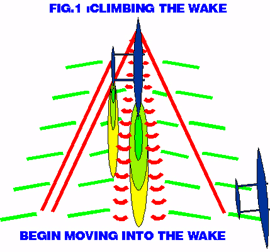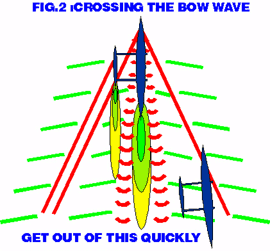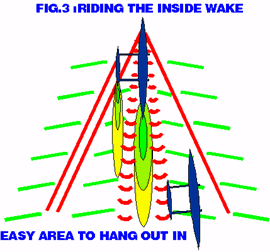Introduction to Wake Riding & Drafting
by Jude Turczynski
Ask permission to republish elsewhere.
In this series of diagrams, it is my attempt to provide information on wake riding and drafting that the reader can easily understand and put to immediate use in almost any craft, and especially in OC-1 though OC-6s. I do believe that using this knowledge can result in boat-lengths of advantage, and that every crew & solo often finds theirselves inescapably close to another canoe on more than one occasion during a race, usually at the start & finish and near the turning points as well as when rounding coastal outcroppings/obstacles.
The following paragraph is of great importance to remember while learning to wake ride:
It's important not to plan your entire race around the use of these tactics. These tactics should be used only when you must stay close to another canoe due to conditions and situations in the race course. It can be more productive to depend on yourself or your crew's ability to pull your way past another canoe without entering their wake field. Some paddlers may lose concentration when trailing behind another canoe and so the speed may drop. Some paddlers get discouraged and some just won't like what you're doing and won't contribute when you take them real close to another canoe.
Another important factor is your steering ability and that of your opponent. You have to be able to maneuver your canoe without over-steering or missing too many strokes. The steersperson in the other canoe should be able to keep the canoe from zigzagging so much that you won't be able to control your position in their wake field. And if you get in real close, you don't want to be playing bumper boats or getting caught up in each others rigging. In many racing regions, bumping a canoe from behind is cause for disqualification.
In order to better communicate positioning and location, I've developed terminology for certain waves and currents found around a moving canoe.

The race course may be narrowing ahead and you may have found yourself trailing an opponent by just a few boat lengths. At some point, a decision is made to try to take advantage of your opponents wake since you cannot escape it. You should have been sizing up that steerspersons ability to keep their boat on course and their tactical savvy and desire to recognize your efforts, and their efforts put a stop to what you're doing. Then, it's time to move inside their wake field.
First, climbing onto the pressure waves that run ahead of the bow wave. These are quite small and have little value, but they definitely don't slow you down. They're largest near the bow wave and they're traveling in almost the same direction that you want to go. If you're going to hang out here, try not to let any part of your canoe touch the bow wave.

Having the bow wave pass under your canoe is disrupting to the glide and trim of your waterline. It can cause the canoe to porpoise and roll as well as turn left and right. When the bow wave is under the forward half of your canoe, it has the effect of making you climb up a wave (up hill). When the bow wave is under the aft half of your canoe, it can make control so difficult that anything gained from riding the wave is lost in excessive draw strokes and ruddering. It's best to just get off of it as quickly as possible. It's not going your direction anyway. Remember, that the bow wave is traveling to the side and not directly forward down course, so a good ride can be had, but you won't be going in the right direction. Whichever part of your canoe that is closest to the bow wave will be drawn up onto it, especially when you're in front of the bow wave (the closer you are, the more intense it becomes). Sitting on the bow wave is not a good place to be!

The 'inside wake waves' are located between the two bow waves peeling off the bow of the canoe that made them. These wake waves are traveling in the same direction as their canoe. The biggest and easiest wake waves to ride are within two boat-lengths of the leading canoe.
As you get closer to the lead canoe, your room between the backwash and bow wave narrows. When this happens, you can place your ama in the draft of the main hull with your main hull between their backwash and right bow wave (straddle the back wash). If you're on the left side of the backwash, trailing their ama draft, it won't hurt much to let your ama climb up on the left bow wave. Remember not to get the bow of your canoe too close to the bow wave which will draw your bow towards the wave causing loss of control. You'll be pulled to one side, you'll over correct to the other... the next thing you know... ZIGZAG.
If you can't take the heat...GET OUT! Look for undisturbed water somewhere else, nurse your wounds and get on with winning. If your race course offers no where to hide, make the best of your bad situation by using these tactics to the best of your ability. You can do this.
The paddle backwash current is traveling in the opposite direction of your desires. This is obviously not the place to be. It will wear you down quickly and discourage your crew. If the steersperson in the leading canoe keeps turning their head to look at you, he may be trying to position himself so that you stay in that back wash. Don't let them "give you the backwash."
Be careful of your steering corrections. The draft behind their main hull is a shallow trough that will draw your bow down in, and could cause you to zig towards it faster than anticipated (overshooting your goal), and overcorrecting to bring it back. Zag!

You hear a lot about drafting. You may seldom experience it for long in a race, especially in an OC-6. Weather and water conditions should be right as well as the crews ability to pull under stress. Remember that these waves, drafts and backwash exist even in rough water although their effect may diminish greatly when the surrounding swell and wind waves are much larger in comparison. When in the draft, your practice and talent will payoff. Drafting is most effective when racing into a head wind. It's then that you can take full advantage of your trailing position in the race, protected from much of the wind. For instance, if the wind is passing over their starboard fore quarter (right front), you'll want to draft in the lee of their canoe (the side that's protected from the wind), at their aft port quarter (left rear). The main hull draft exists for about one boat length behind the leading canoe, just enough room for you to slip in and catch the ride.
Here, it's important to have a telepathic connection to your stroker. Hopefully, you both think alike and communicate well with few words. The stroker can make steering in this tiny draft space a lot easier by very slightly drawing the bow into the desired position. To avoid collisions, you can ask the stroker if the bow of your canoe will clear the stern of the leading canoe by yelling a single word, like "CLEAR?". When the steersperson keeps asking, "CLEAR?" the stroker can assume that the steersperson wants the canoe to back off enough to clear the leading canoe and so the stroker can ease back on the power just a little to back off enough to clear (only the stroker should back off).
If your racing rules disqualify you for bumping a canoe in front of you, don't overlap your bow to their stern. If your racing rules don't disqualify you for bumping the canoe in front of you, it's okay to overlap with the leading canoe for just a foot or two. There is an advantage to doing this in that when their stern swings into your bow, your canoe will be in the right place. When his stern swings away from your bow, you can't overcorrect when you try to match his movement because his canoe will stop you. This is generally regarded as extremely uncool and if you should accidentally spin them, you'll be disqualified. The draft does actually exist as far forward as the rear iako. Drafting like this can lead to collisions and tangles that aren't worth it. They could decide that they've had enough of this dangerous interference and push you away. If they do, you deserved it. Don't put people in danger and obey your racing rules.
Though you can't see the main hull of the leading canoe very well from this position, you can see their ama just fine. By looking at the ama, you can tell which way your opponent is turning and how far ahead they are.
If the conditions are right and the crew is experienced, you can let the draft pull you along over great distances allowing your people to catch their breath in preparation for the power-up to pass. I've seen canoes draft for miles and then, pass in the last mile to win. No doubt, it can work!
In the Draft, trailing the ama. This is a really great drafting position to be in, even in head winds. Watch the main hull to tell where your opponent is going. The ama draft extends some 30 feet behind the rear iako and very close behind that draft are the wake waves, so you always have very favorable stuff behind the ama. Be careful not to catch your bow under their rear iako. You can easily get tangled with the other canoe here.
The draft is best within a foot of the ama and is worth trying to ride if the conditions are right. This is an especially good place to be if there's a head wind coming from the right fore quarter.
All other techniques here are the same as when drafting the main hull of your opponent.
These waves are traveling with your direction and can help you if they don't cause you to spend too much time drawing and ruddering. The closer your stern is to the bow wave, the more difficult it is to control the canoe.
If you're in shallow water, say, less than 20 feet deep, you might be better off moving far enough away from your opponent as not to be in their outer wake waves. I believe they are pressure waves that can bounce off the bottom and slow down your canoe if the distances and positions are right.
When you're in the lead canoe, you can still use the knowledge of wake riding and drafting to your advantage! It's important to remember not to let this strategy carry you off course. If you can limit your side to side movement to 50 feet over a half mile of race course, that's fine.
Dropping a bow wave across seats one and two of your opponents canoe will cause their boat to porpoise and climb the wave. Don't spend too much time and attention looking behind you. If you dropped it on him for a moment, that's plenty. If they're unaware enough to wallow in it, give 'em all they'll take. But let me remind you, stay focused on YOUR progress, not theirs.
If you're in a head wind from over your right bow, you might drop your right bow wave on them. Keeping them from finding your lee and making sure they stay exposed to that wind during all their attempts find a good position. This tactic is probably the most effective method of impeding the progress of an opponent. Intentionally performing this tactic may be against the rules of some racing associations! If so, let me know which association you're with.
As much as we try to anchor our paddles in the water and not let them push water behind us, we still do ...a lot! This water is moving at such a significant speed and volume that it can be used to slow your opponent behind you. Here again, don't get off course. Your race course is always in front of you.
This strategy works best when your opponent is behind you within a couple boat lengths. When you keep turning around to see if you have a direct hit, your opponent will know what you're trying to do and they will compensate. They may decide not to draft you or wake ride you at all, which may also be to your advantage. Remember not to make sudden corrections, rudders or drawstrokes that may slow your progress and allow your opponent to catch up and find your draft.
When leading in a head wind coming over your right bow, you may want to position yourself to their left. Feeding them your right side backwash thus also keeping them in the wind away from your lee. If they're close enough for you to use this strategy, they're near enough to find your draft. That's okay, cause you're gonna smoke 'em anyway!
NEXT CHANGE, ...POWER-UP!!!!!